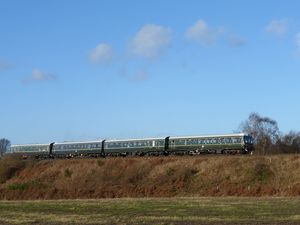Class 108 DMU
Contents
BR Class 108 General Information
The BR Class 108 diesel multiple units (DMU) were built by BR at Derby between 1958 and 1961. They are mainly of aluminium construction, with steel cab ends. Typically they were operated in 2, 3, or 4 car sets. A total of 333 cars were built, comprising[1]:
| Car type | Description | Number built | Seating capacity as built | SVR Examples |
|---|---|---|---|---|
| Driving Motor Brake Second (DMBS) | Powered driving car | 152 | 52 second class | M50933, M51941, M51935 (scrapped) |
| Driving Motor Composite with lavatory (DMCL) | Powered driving car | 58 | 12 first 53 second | M52064 |
| Driving Trailer Composite with lavatory (DTCL) | Unpowered driving car | 106 | 12 first 53 second | E56208 |
| Trailer Second with lavatory (TSL) | Unpowered centre car | 11 | 68 second class | NE59250 |
| Trailer Brake Second with lavatory (TBSL) | Unpowered centre car | 6 | 50 second class |
Withdrawal of the class from service began in 1990. Unlike some other early models of DMU, the class 108 did not contain asbestos, making them suitable for preservation on heritage railways.
DMU Group vehicles
The DMU group operates five cars. These can be used as separate three car and two car units, but are usually combined to form a five car unit for purposes such as the summer Scenic Cruises. From time to time maintenance requirements may result in operation as a four car unit.
The first 2 cars, DMBS M51941 and DMCL M52064 arrived on the SVR from Doncaster via Tyseley on 30 March 1990, initially on a two year loan. The 2-car set was formally commissioned on 13 October 1991. After a return trip from Kidderminster to Bridgnorth, the MD of Regional Railways presented the key to officers of the DMU Group.[2]
Unpowered centre car TSL M59250 arrived on 7 June 1992 and entered service in November of that year to form a 3-car unit. The centre car includes the Group’s main bar facility, called 'The Travelling Tavern'.
A fourth car, DMBS M51935, was purchased in June 1992 as a source of spares, but by 1993 had been restored and entered service.
In autumn 1996 the Group acquired a fifth car, unpowered DTCL 56208 which arrived on 21 December, giving an additional 65 seats capacity.
M51935 was extensively damaged by fire in May 2008 in what was believed to be an arson attack. Subsequently it left the SVR to be broken for spares elsewhere. The Group acquired DMBS M50933 as a replacement. In 2010 alterations were made for the conveyance of wheelchair passengers.
Workings in preservation
- In 2004, all five cars took part in the Railcar50 event, participating in a 12 car special which was the longest DMU formation ever to operate in preservation[3].
- For much of 2018 and 2019 the DMU was unavailable for service for attention to various mechanical and electrical issues. It being the only diesel powered train capable of providing a heated train on the SVR, a mixture of steam and hired-in diesel locomotives deputised for the winter services and the summer Scenic Cruises.
Gallery
See also
References
- ↑ BR Class 108 on Wikipedia
- ↑ SVR News 102
- ↑ http://preserved.railcar.co.uk/
Links
| ||||||||||||||||||||||||||||||||||||||||||||||||||||||||||||||||||||||||







